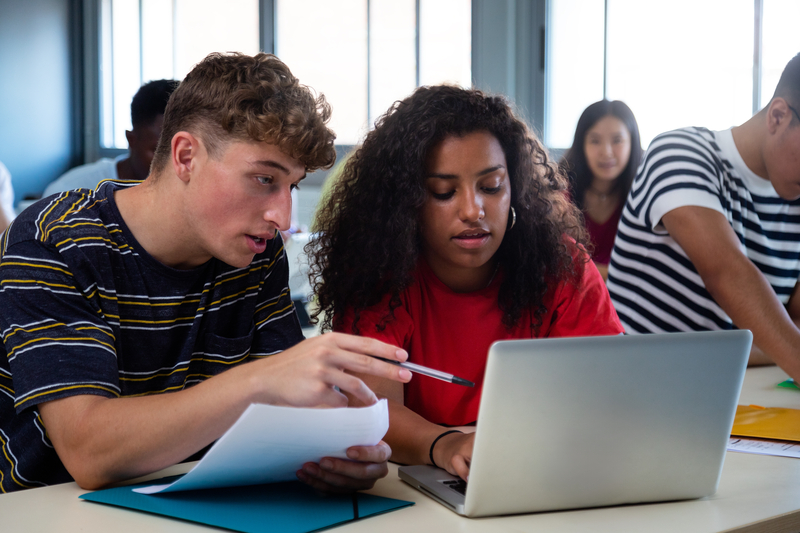The last grading period of a school year can bring both dread and excitement for students and teachers. Standardized tests and a frozen tundra of motivation pale in the face of blooming flowers and outdoor activities that compete for students' interest. This year poses an added complication: After the threat of COVID-19 closed schools in March, teachers and students have been thrown into distance learning, many for the rest of the year, with little to no training or preparation.
It is important in these times of uncertainty to engage students in meaningful instruction with very specific learning targets. Whether they are ready or not, students have been placed in the driver's seat of their learning and need tools to succeed while they have more control of their schedule and pace.
So, how do educators not just "get through" this period, but actually inspire students to continue learning? I have opted for a full-scale, student-driven passion project. In my opinion, this is the absolute best assignment I could give my students right now, for the following reasons:
- They have free choice in what they learn for the duration of the unit. They can choose a topic they want to learn more about, a skill they want to improve upon or learn, or create something new.
- They have control in setting goals that work for them and their home schedule.
- Many will be intrinsically motivated simply to fill the time.
- I use competency-based grading, so students are already familiar with the process of learning for feedback and using scoring guides as benchmarks instead of working for a grade. This approach is especially important in crisis learning because there is inequity of experience among my students based on home life and access to materials.
My students are in middle school, but passion projects can be easily modified for high school or upper elementary students. In past years, students have learned metacognition and reflection skills, goal setting and project management, growth mindset mentality, curiosity, digital skills, and informative writing, research, and communication. The outcomes have been beyond any other work I've seen in eight years of teaching. I've been amazed by students' creativity, pride, and genuine excitement to share what they created. They've written songs, learned instruments, written code for a video game, learned to cook meals, written stories, learned new languages, and researched a lot of interesting topics.
Once students pick a topic, they learn how to set goals, manage a project, seek feedback, reflect on their progress, and report on their learning using technology. These are the two main assignments:
- Weekly learning reflections with evidence of note taking and progress toward the final passion project presentation.
- Passion project final presentation and reflection on the process.
Setting Up a Passion Project
This year, the show will go on with a few modifications. For the six-week assignment, I will use video explainers; Google Classroom posts; and a Passion Project packet with step-by-step directions, handouts, and scoring guides. I will also be available for questions and meetings in our class Google Meet during set office hours.
Week One
This week, students familiarize themselves with the project timeline and requirements, brainstorm ideas, and propose what they would like to spend their time on. On Day One, students will
- Review an introductory post in Google Classroom and the overview and grading process. Respond with one question or one thing they noticed.
- Watch the 2014 #20Time projects in 4 minutes video of other students sharing passion projects and read a list of 350 Passion Project Ideas.
- Complete the brainstorming guide on page 3 of the packet.
On Days Two to Five, students will:
- Watch explainer videos on how to set goals, use feedback in the creative process (page 4 in the packet), and reflect weekly on progress (pages 8–9).
- Complete the passion project proposal and Week One reflection via blog or vlog and self-score (pages 8–9), using that to ask for feedback and adjust presentation according to the score they would like to earn.
Week Two
This week, students finalize their project, reflect on what they've learned so far, and begin their research and creation. Students will
- Fill out the Passion Project Weekly Learning Plan and turn in for review. (I reach out individually to students who appear to be struggling with this step).
- Watch videos about research, good note taking, and citing sources. Begin researching to learn and fill out the Week Two notes table (page 5).
- Do something with learning (write an exposition, make a meal, write code, learn some chords, etc.) and document what's being done along the way.
Below is a sample of what a weekly learning plan might look like. Before students create the plan, they decide some basic information, including:
My Passion Project Topic: Women in the American Revolution
Final Product: A children's book on five important women in the American Revolution
Goals—This week I want to learn/build/practice:
- Make a list of five women from the American Revolution I want to showcase in my book.
- Learn about and take notes on one of the five women I am including in the book.
- Write the first two-page spread of my book on the woman I researched this week.
Teacher Sample: Passion Project Weekly Learning Plan, Week 2
Day of the Week | Learning Plan for Each Day (What do you hope to accomplish?) | Did you meet your daily goal? Why or why not? |
|---|---|---|
| Monday | Research life during the American Revolution and major events. | |
| Tuesday | Research important women in the American Revolution and make my list of five that I want to showcase in the book. Select the woman I want to write about this week. | |
| Wednesday | Take notes on the woman I want to write about this week, noting the things that I most want my audience (children) to know about her influence and effect on the American Revolution. | |
| Thursday | Use the notes I took yesterday on an influential woman from the American Revolution to write a two-page spread for my children's book (which will be my final product). | |
| Friday | Complete my Week 2 reflection blog, answering all the prompts and including a picture of my notes and the work I completed this week. |
Weeks Three to Five
In these weeks, students continue with their research, reflection, and self-scoring:
- Fill out the Passion Project Weekly Learning Plan. Research to learn about the topic, and cite sources using MLA formatting (pages 6–7), and again do something with the learning.
- Complete the Week 3, 4, and 5 reflection via blog or vlog.
- Review the scoring guides (pages 8–9) and self-score, adjusting presentation accordingly.
Week Six
This week is when students create a presentation to show what they learned. Students will
- Decide what delivery format to use and review the product presentation content must-haves and grading rubric (page 10).
- Complete the Passion Project self-assessment (page 12).
- Participate in a virtual learning showcase. (I share their projects to a digital platform for students, parents, and staff to view and leave questions and comments).
Schools in Missouri have officially closed their doors for the remainder of the school year, and the students I have spoken with are disappointed and trying to figure out what that means for them. Now, more than ever, it is important to give students consistency in learning opportunities with flexibility in pacing and depth. Because the passion project lasts four to six weeks and can take place remotely, it provides much-needed stability for students who are already facing so many changes.
Rather than busy work, this is an opportunity to equip students with the real-life skills of measured risk taking, self-reflection, project management, and goal setting. The students I have spoken with during this period of remote learning are bored, desperate for social connection, and seeking direction. This assignment allows for an enriching finish to a disjointed school year.








